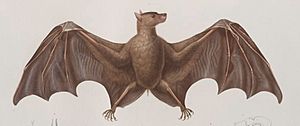Bare-backed fruit bat facts for kids
The bare-backed fruit bat (Dobsonia moluccensis) is a special type of bat. It belongs to the family of fruit bats called Pteropodidae. These bats are known for eating fruit. They live in parts of Asia and Australia.
Quick facts for kids Bare-backed fruit bat |
|
|---|---|
 |
|
| Conservation status | |
| Scientific classification | |
| Genus: |
Dobsonia
|
| Species: |
moluccensis
|
| Synonyms | |
|
|
Contents
What's in a Name? (Taxonomy and Etymology)
Scientists first described this bat as a new species in 1830. Two scientists, Jean René Constant Quoy and Joseph Paul Gaimard, gave it its first scientific name.
They called it Hypoderma moluccensis. The word "moluccensis" in its name means "belonging to the Moluccas." The Moluccas are a group of islands where this bat is found.
How to Spot a Bare-backed Fruit Bat (Description)
This bat has brown fur. Its feet have special white claws that stand out. It is a bit smaller than another bat called the New Guinea naked-backed fruit bat.
Male bare-backed fruit bats usually weigh between 380 and 500 grams (about 0.8 to 1.1 pounds). Females weigh from 325 to 525 grams (about 0.7 to 1.2 pounds).
Its ears are pointy. Unlike some other bats, its second fingers do not have claws. A unique feature is how its wings attach. They connect to its back along its spine, not along the sides of its body.
Life and Habits (Biology and Ecology)
The bare-backed fruit bat has a specific time of year when it has babies. This is called being a "seasonal breeder." They usually mate between April and June.
Female bats give birth to their young from mid-August through November.
Where Bare-backed Fruit Bats Live (Range and Habitat)
You can find the bare-backed fruit bat in several countries. These include Indonesia, East Timor, Papua New Guinea, and Australia.
They live in areas from sea level up to about 2,700 meters (around 8,858 feet) high.
Keeping Bats Safe (Conservation)
As of 2016, experts consider the bare-backed fruit bat a "least-concern species." This means it is not currently in danger of disappearing.
The International Union for Conservation of Nature (IUCN) gave it this status. They decided this because the bat lives in many different places. Also, there are lots of them in the areas where they live.
Images for kids
See also
 In Spanish: Dobsonia moluccensis para niños
In Spanish: Dobsonia moluccensis para niños


